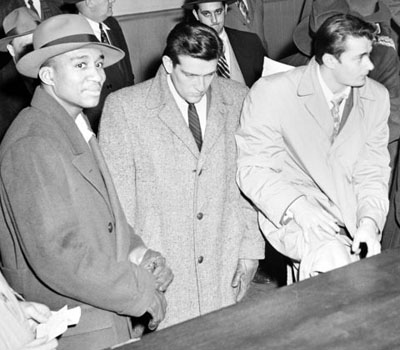While
CCNY was still basking in the glow of winning both the NCAA and NIT Tournaments in the same season, a report appeared in the
New York Times.
- Bradley F Paul Unruh revealed that he had been offered a bribe during the NIT. He was approached by an unidentified man who offered him $100 to keep Bradley's margin of victory under seven points and $500 if the margin was under three.
- Basketball was the most heavily bet sport in America, but it was also an easy sport in which to shave points or even dump a game. A player might not lose the game for his team but could easily miss a few shots or let the man he guarded make a shot or two to keep the victory margin below the point spread.
Basketball had already endured several gambling scandals.
With five of the top six players from the '49-50 team returning,
CCNY was expeced to contend for the national championships again.
- Ranked #6 in the preseason AP poll, the Beavers won their first two games, including a 71-69 squeaker over Brigham Young.
- Then came a puzzling 17-point loss to Missouri as City hit only 12 of 60 FG attempts for a dismal 20%. Floyd Layne, Ed Roman, and Alvin Roth missed shot after shot. Three players fouled out in the team's worst showing in two years.
- Ed Warner missed several games with an ankle injury, including close losses to Oklahoma and Arizona. He wasn't at full strength in the loss to St. John's, which was considered the strongest team in the New York area. That ran the Beavers' record to a shocking 6-5.
The hottest club in NYC was Long Island U.
- Despite their 12-0 record, the Blackbirds were widely assumed to be shaving points so that there was virtually no betting on their games.
- They won big in the games in which they were favored by narrow margins but my only one or two points in games they were expected to win handily.
In this suspicious atmosphere, Stan Isaacs wrote a column in the New York Daily Compass that created widespread speculation.
- According to Isaacs, bookmakers had been shutting off bets whenever a "certain local team" was playing. He said the contact man was a former player who was "one of the biggest names in collegiate basketball a few years ago."
- It was widely assumed that the team in question was LIU.
On January 17, five men, two former Manhattan players and three professional gamblers, were arrested for trying to fix the Manhattan-DePaul game in Madison Square Garden.
- The arrests followed an attempt to bribe Manhattan's star C Junius Kellogg to fix the Manhattan-DePaul game the night before. Kellogg reported the offer immediately and in so doing set in motion a chain of events that ripped apart the fabric of college basketball in the New York area.
- The arrested players confessed to dumping three games the previous season and accepting money to try to exceed the point spread in two other games in the 1949-50 season.
- One of the players told police, "Why did they have to catch us when so many other guys are doing it? This has been going on for years."
After a month-long investigation that included a "sting" operation, District Attorney Frank Hogan announced the arrest of six men on charges of bribery.
- Three of the culprits paid the bribes. The other three took the money - Ed Roman, Al Roth, and Ed Warner, all of CCNY.
- The players admitted fixing the scores of three games during the 1950-51 season. City was favored in each game but lost every one. They each received $1,500 for the Missouri game and $1,000 for Arizona. They were due $1,000 each for the Boston College game (another defeat) but had not received the payment yet.
- Bail was set at $15,000 for each of the players.

L-R: Ed Warner, Ed Roman, and Al Roth at their arraignment
As always happens with an investigation, one lead led to another which led to another. Inquiries were conducted in 13 states. Cheating in past seasons was exposed.
- Kentucky players had thrown the first round game in the 1949 NIT, thus costing the NCAA Champion Wildcats a chance to capture both tournament titles as CCNY did the following year.
- Kentucky canceled its 1952-53 basketball schedule after Coach Adolph Rupp was suspended by the SEC for a year. The name of star 7' C Bill Spivey, one of the accused point shavers, was kept off the 1953 draft roster and he was barred permanently from playing in the league.
The scandal led to changes in NCAA rules.
- A CCNY official's reaction to the accusations against the three players was, "I can't believe our boys could do such a thing."
- A reporter retorted, "Why not? You paid them for campus jobs they didn't work at. You gave them passing grades for classes they didn't attend. You bribed them to play for you. The gamblers bribed them not to play too well. What's the difference?"
- The scandal tarnished the Beavers' great 1949-50 season when they won both the NCAA and NIT Tournaments. But their titles were never vacated.
After the 1950-51 basketball season,
CCNY deemphasized its athletic program and dropped down to a lower division of NCAA competition.
LIU shut down its entire athletic program from 1951-57 and did not return to Division I until the 1980s.
Reference: The Game They Played: The True Story of the Point-Shaving Scandal That Destroyed One of College Basketball's Great Teams, Stanley Cohen (2001)